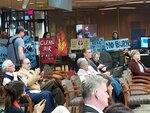By Cam Gordon
The Hennepin County Board has set a time frame to end operations at the downtown garbage incinerator. With unanimous agreement on Oct. 24 2023, they directed staff to provide them with a closure plan by February 2024 with options to shut down the facility sometime between 2028 and 2040.
Hennepin County Commissioners Irene Fernando from District 2, Angela Conley from District 4 and Jeffrey Lunde from District 1 authored the resolution.
“As a North Minneapolis resident, I have advocated for closure of the HERC since long before I was in elected office,” wrote Fernando. “I believe there is a path to stop burning trash as soon as 2028, but aggressive action is needed from government partners to achieve this timeline.”
The Hennepin County Energy Recovery Center (HERC), as it is called, is in the North Loop neighborhood and burns roughly 1,000 tons of garbage each day. The garbage is collected from the entire county, and includes all residential waste collected by the city of Minneapolis.
“I support shutting down the HERC on the quickest timeline possible,” wrote District 3 Commissioner Marion Greene, who represents the residents of Southwest Minneapolis and St. Louis Park. “Establishing a suitable alternative to incineration should be the number one priority of all stakeholders and communities that currently use the HERC, and, importantly, the first priority of our partners in state government.”
County staff have reported that roughly 75% of what is burned at the HERC comes from Minneapolis, and the other 25% comes from Bloomington, Champlin, Deephaven, Excelsior, Hopkins, Loretto, Maple Plain, Medina, Minnetonka Beach, Osseo, Robbinsdale, Richfield, St. Bonifacius, St. Louis Park, Tonka Bay, and Wayzata.
All the materials disposed of in the city’s trash bins in Southwest Minneapolis are taken to the HERC. Some metals are removed to be recycled, but nearly everything else is burned there. Some of the heat is used to produce steam and generate electricity, and the remaining ashes are sent to be buried in a landfill.
TOXIC SMOKE
According to the Minnesota Center for Environmental Advocacy (MCEA), the HERC releases carbon monoxide, hydrochloric acid, nitrogen oxides, sulfur dioxide, and particulate matter that contribute to health problems such as asthma, heart conditions, and cancer. The facility also emits lead pollution, which can cause organ and brain damage, particularly in children.
Incineration has likely become more harmful in recent years as more plastic is burned. Plastic creates dioxins, a major carcinogen that is toxic as well as the active ingredient in Agent Orange.
The Environmental Protection Agency estimates the HERC released 173,254 tons of carbon dioxide, 404 tons of nitrous oxide, and 44 tons of particulate matter (or soot) in 2019.
AIR POLLUTION CAUSES HARM
Evan Mulholland is the director of the Healthy Communities Program at MCEA, lives in Tangletown, and is one of Greene’s constituents. “I’m glad the Hennepin County Board finally started the process to shut down the HERC trash burner,” he said. “Our understanding of the grievous public health impacts of air pollution has advanced since the HERC was built in the 1980s, and we now know that even very low levels of air pollution can cause harm. The air pollution across the city needs to be reduced, but particularly in North Minneapolis where we have concentrated both highways and major polluters.”
Opposition to the facility was intense before it was built and has grown recently. The Zero Burn Coalition was formed earlier this year and has been leading community efforts to close down the facility.
It includes MCEA, the Minnesota Environmental Justice Table (MEJT), MN350, Sierra Club North Star Chapter, Rusty & the Crew, Sunrise Twin Cities, UMN Students for Climate Justice, Clean Water Action MN, Teamsters 320, Minnesota Nurses Association, Minneapolis Federation of Teachers, Health Professionals for a Healthy Climate, East Phillips Neighborhood Institute and others working “to end toxic trash burning at the HERC so that the county can fully invest in moving to zero waste.”
COALITION ASKS FOR 2025 CLOSURE
The facility opened following passage of the Minnesota Waste Management Act of 1980 that established waste-to-energy as preferable to landfills. In February 2023, the Minnesota State Legislature redefined HERC as a non-renewable energy source starting in 2040 and required the county to make a plan for closing the facility.
“While this is still not what the community demanded, a 2025 closure, or at least a much sooner timeline, it is an important step,” wrote Nazir Khan and Krystle D’Alencar of MEJT after the vote. “We lodged ourselves into the small opening that came out of last legislative session and pried it into a major opportunity just as the county was trying to close that opening in the last couple of months.”
In August, the coalition helped turnout over 100 people who attended a county board meeting to advocate for a shutdown. This included health practitioners from North Minneapolis who delivered a letter calling for closure due to the health impacts of air pollution. The group asked for a shutdown by 2025, greater transparency around a closure plan and restitution for communities harmed by the burning.
what comes next for trash?
On Sept. 21, county staff recommended setting a closure date sometime between 2040 and 2050. Then, on Oct. 10, Fernando, Conley and Lunde introduced their resolution for a closure between 2028 and 2040.
By the board meeting on the 24th, the commissioners had received a letter supporting a rapid shutdown signed by 22 state legislators, including Southwest legislators Frank Hornstein, Jamie Long, Scott Dibble, Esther Agbaje and Emma Greenman. They offered to meet “within days of the county’s passage of this resolution to discuss new legislative initiatives, so that Hennepin County will have ample time and opportunity to develop a legislative agenda to meet your Dec. 1, 2023 goal to finalize next year’s county legislative platform.”
The resolution calls for the county administrator to develop a plan by Feb. 1, 2024, for the closure of the facility between 2028 and 2040 with contingency plans for a sooner closure if required by the state legislature or the county board.
“I am really looking forward to the report, and I have faith that our administrator has the tools and the brilliance to bring us a plan that will bring about dignified closure of this facility,” said Conley. “My eyeballs are on the shorter time frame.”
Staff have also been instructed to propose state legislative priorities by Dec. 1, 2023, to support the county’s Zero Waste Plan, clarify waste management responsibilities, and help fund the closure, as well as the county’s waste reduction and climate action efforts.
The board also authorized hiring a consultant to help find replacement energy sources for the energy HERC supplies, and directed staff to meet with elected officials from the cities that use HERC to gather their feedback on the closure plan and potential state law changes by Jan. 1.
“Finding a solution to trash incineration on an accelerated timeline will only be possible with coordination from all relevant entities, which includes providing adequate funding and resources to address this urgent manifestation of environmental racism,” said Greene. “A zero-waste community remains our shared goal, and as we work together towards that goal through reduction, composting, recycling, and reusing, we need the state and cities that use the HERC to join in coordination to find a suitable alternative as quickly as possible.”
Fernando wants to ensure that the energy the HERC provides now is replaced with a renewable option, and that cities adequately staff recycling and organics programs, particularly for multi-unit dwellings. She is also calling on cities to establish organized collection systems for multi-unit apartment buildings, require large waste generators to have diversion plans, raise standards for haulers, and require recycling on construction and demolition projects.
“We need to be working with each other to ensure that each partner and each player is working as boldly and aggressively as we can to meet the zero waste and climate action goals, as well as to meet [those of the] racism is a public health crisis declaration,” Fernando said. “So, there is a commitment to stop burning trash, and we look forward to doing the heavy lifting along with community and partners to achieve that goal.”
“The next few months leading up to the county staff’s closure plan release by Feb. 1 is crucial,” wrote Khan and D’Alencar. “Our pressure and organizing has moved the county so much. And it still feels like we are just getting started.”
“The HERC is one of the largest single polluters in the entire county. And, burning trash is not a climate solution, either, and I doubt it ever was one.” said Mulholland. “We should move as quickly as possible to shut down the HERC. A shutdown date of 2025 is entirely possible.”





Comments
No comments on this item Please log in to comment by clicking here